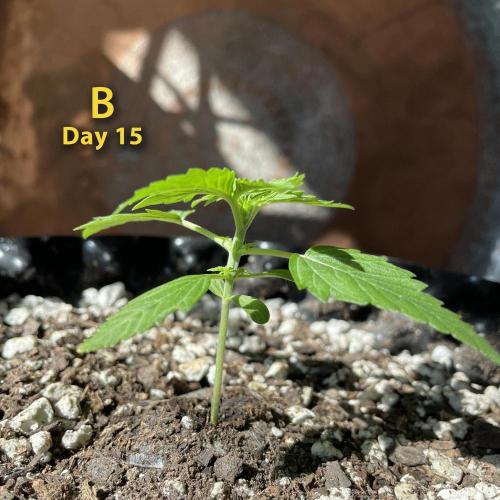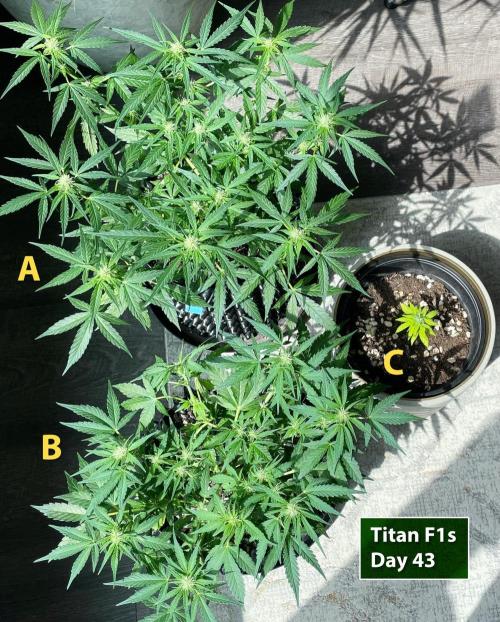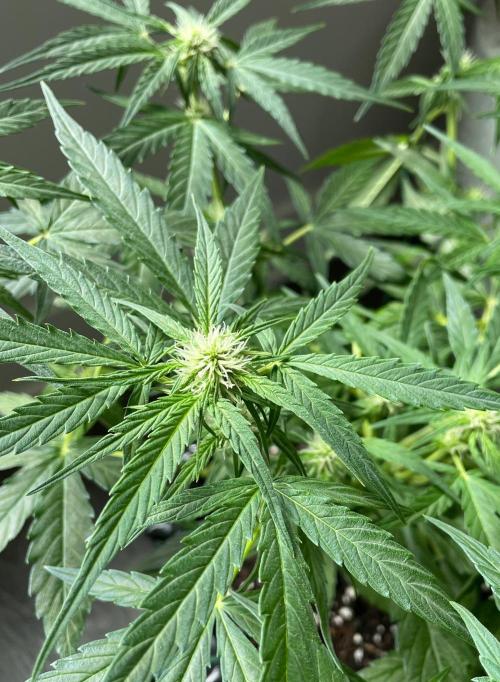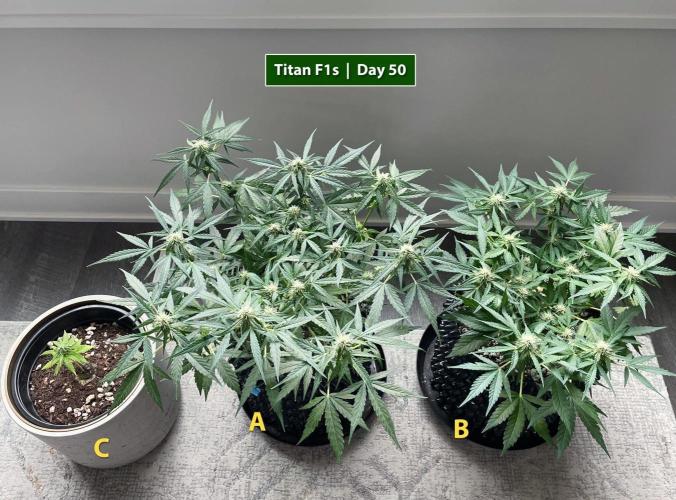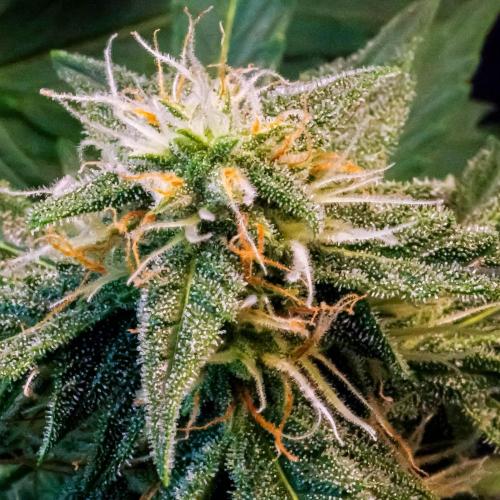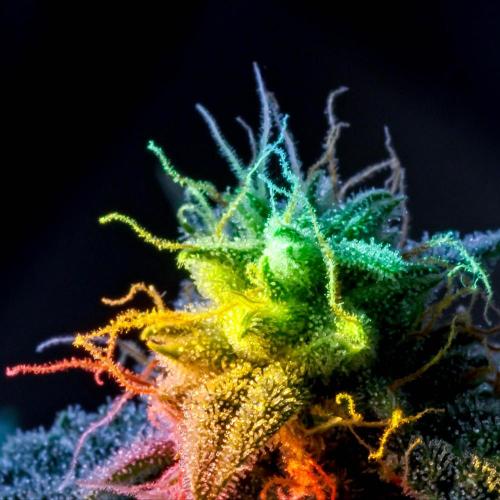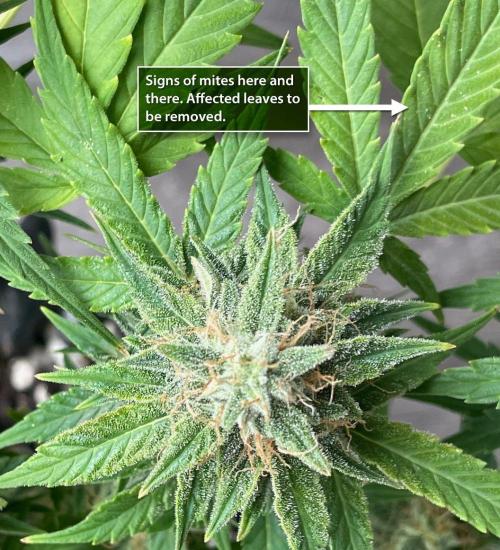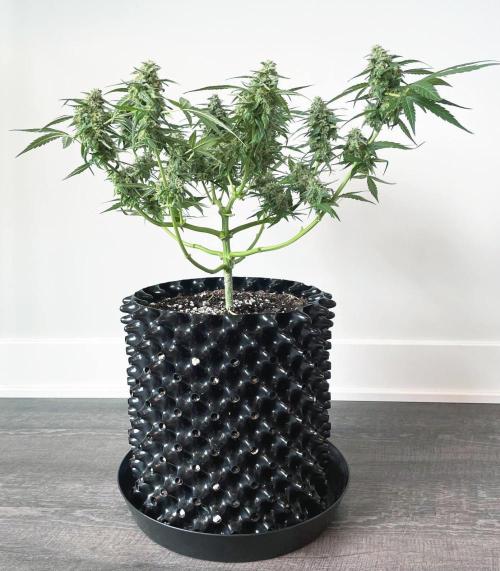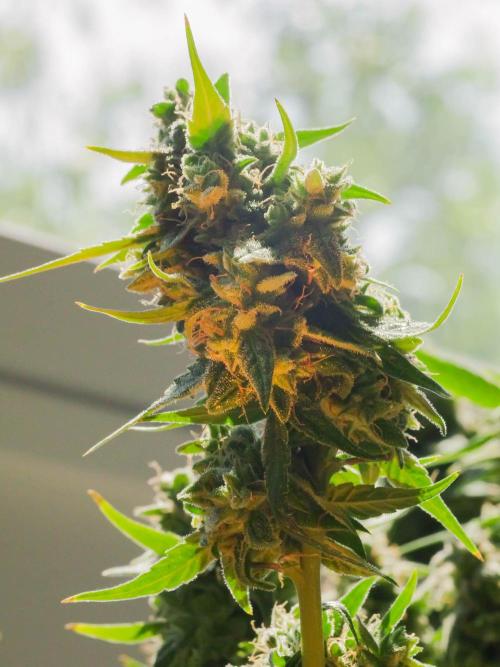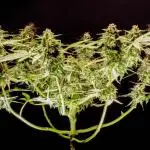The Grow Awards 2026 🏆 



















Titan F1 Spring Window Grow
Other
Pumice
Indoor
Room Type
Intermittent Humidity Dome
weeks 1
Prune first node branches
weeks 3
HST
weeks 3
Topping
weeks 3
Leaf tucking
weeks 3-4, 7-8
LST
weeks 3-6
Defoliation
weeks 6-8, 10-12
9 liters
Pot Size
0.25 liters
Watering
Start at Harvest
G
Germination10mo ago
drakkon The intent of this grow is to treat a small batch of autoflowers like houseplants to see how they perform. They're placed with good southern exposure, and will be moved manually in the afternoons to maximize hours spent under full sun.
Three Titan F1 autoflower seeds from RQS germinated in peat pellets on 3/6/25 (third day after planting).
Individuals labeled A, B and C in photos. Peat pellets planted in containers as shown, with no water added to medium in advance of planting (used as it came out of the bag). Ratio of media varies for each, as follows:
A: Happy Frog soil amended with pumice (appx. 75% soil + 25% pumice).
B: Happy Frog soil amended with more pumice (appx. 65% soil + 35% pumice).
C: Equal mix of Happy Frog and unidentified leftover potting soil from houseplants, plus 10% pumice.
5 likes
2 comments
Share
Used method
Peat Pellet
Germination Method
1
Week 1. Vegetation9mo ago
3.81 cm
Height
20 hrs
Light Schedule
24 °C
Day Air Temp
No Smell
Smell
30 %
Air Humidity
21 °C
Night Air Temp
9.09 liters
Pot Size
0.04 liters
Watering Volume
drakkon All three Titan F1 seedlings are healthy and growing nicely. They now have two visible sets of true leaves, with the third set just barely sprouting. Each seedling received 1.5 ounces of tap water daily, poured by hand in expanding rings. They spent about two-thirds of their time in ambient air with a humidity of 30–35%, and one third under small humidity domes.
The seedlings received approximately 12 hours of bright daylight each day. It's been mostly sunny the past week, so the majority of that was direct sun (through a large window pane). They also received another 6–10 hours of interior or houseplant-style lighting during the evenings and overnight hours. Since they're still small, I can move them under kitchen-cabinet lights or other low-wattage LEDs with little effort, but I still allow them to get the occasional few hours of darkness.
Once they grow larger and the days get a little longer, I'll phase out the practice of moving them near interior lights, and will only move them to follow the sun's rays.
Plant A resides in a 2.4-gallon air pot ("yellow" size) containing Happy Frog soil and pumice (~75/25).
Plant B resides in a 2.4-gallon air pot ("yellow" size) containing Happy Frog soil and pumice (~65/35).
Plant C resides in a ~1.5-gallon nursery pot containing Happy Frog soil, unknown leftover potting soil, and a trace of pumice (~45/45/10).
4 likes
1 comment
Share
Used techniques
Intermittent Humidity Dome
Technique
2
Week 2. Vegetation9mo ago
6.35 cm
Height
20 hrs
Light Schedule
24 °C
Day Air Temp
No Smell
Smell
30 %
Air Humidity
21 °C
Night Air Temp
9.09 liters
Pot Size
0.11 liters
Watering Volume
Nutrients 1

V-N Dry Soluble 10-2-2
0.65 mll
drakkon All three Titan F1s have grown in size over the past week, which included a mix of mix of sunny, partly sunny, and cloudy days. Plant A has grown the most, followed by B, then C, which grew noticeably less than either A or B.
Plant C is little yellowish compared to the other two. I suspect low N, so on day 15, I fed it with 4 oz of water with Alive Organics V-N Dry Soluble 10-2-2 mixed at 1/2 tsp per gallon. I also fed plants A and B with 5 oz of the same product, but mixed at 1/4 tsp per gallon.
I've grown a few other kinds of autoflowers over the past year and a half, and I recall one RQS Quick One and one RQS Watermelon that were stunted. Now that I think about it, those two may have included soil from a bin that I keep for houseplants and patio plants (Like Titan Plant C). Whether Plant C works out or not, I'll be sticking with Happy Frog (+ pumice) for my soil grows for the foreseeable future.
3 likes
comments
Share
3
Week 3. Vegetation9mo ago
10.16 cm
Height
20 hrs
Light Schedule
22 °C
Day Air Temp
No Smell
Smell
30 %
Air Humidity
21 °C
Night Air Temp
9.09 liters
Pot Size
0.11 liters
Watering Volume
Nutrients 1

V-N Dry Soluble 10-2-2
0.65 mll
drakkon Plants A and B continue to grow nicely, reaching appx. 4" in height, while plant C remains stunted. Going forward, I will focus most of my attention on plants A and B, but I still plan on keeping C all the way to the end.
I topped plants A and B above their fifth nodes on days 21 and 22, respectively, and pruned their first-node branches and leaves at the same time. After topping and pruning them, I gently tucked some leaves to expose the lower branches to more light. I will continue to tuck leaves in the coming weeks.
See photos for further details.
4 likes
comments
Share
Used techniques
HST
Technique
Topping
Technique
LST
Technique
Leaf tucking
Technique
Prune first node branches
Technique
4
Week 4. Vegetation9mo ago
12.7 cm
Height
16 hrs
Light Schedule
22 °C
Day Air Temp
No Smell
Smell
30 %
Air Humidity
21 °C
Night Air Temp
9.09 liters
Pot Size
0.19 liters
Watering Volume
Nutrients 1

V-N Dry Soluble 10-2-2
0.65 mll
drakkon Plants A and B continue to grow nicely, and their rate of growth is picking up speed. I'm still feeding them each time they get water, using Organics Alive Dry Soluble 10-2-2 at half the recommended concentration (1/2 tsp per gallon). For the past week, they've received 5–7 ounces each day. Leaf tucking continues, and I started to gently train plant A, which is a little ahead of plant B.
The week was a little more cloudy than I'd like, so I decided to give them a small boost of low-wattage LEDs during those times, and in the evenings and nights, too. On sunny days, they get no supplemental light during the day or night (light hours estimated for diary entry).
See photos and labels for additional details.
Plant C remains stunted, and I blame the poor unknown soil it's planted in. I'm not intervening, but will allow it to finish out its life cycle.
3 likes
comments
Share
Used techniques
LST
Technique
Leaf Tucking
Technique
5
Week 5. Flowering9mo ago
20.32 cm
Height
18 hrs
Light Schedule
22 °C
Day Air Temp
No Smell
Smell
32 %
Air Humidity
21 °C
Night Air Temp
9.09 liters
Pot Size
0.19 liters
Watering Volume
Nutrients 1

V-N Dry Soluble 10-2-2
0.65 mll
drakkon Plants A and B grew quickly throughout the week, and they are beginning to show the first signs of flowering. Tiny plant C grew only a little, and is also starting to flower. All three are getting about 14 hours of light through the windows each day, which includes up to ~9 hrs of direct sun on sunny days. The intensity and duration of the daylight is increasing daily as we advance through spring. The plants also receive some supplemental light from low-wattage LEDs on a haphazard basis (light-schedule entry is an estimate). The more and brighter the sun shines, the less I worry about supplemental lighting.
Over the course of the week, the two larger plants received about 12–15 ounces of water (with V-N dry soluble at 1/2 tsp per gallon) every two or three days. Soon, I will begin phasing in some Organics Alive V-PK Dry Soluble 0-10-8 bloom nutrients.
Training continues on the two larger plants, with each one now sporting eight distinct tops (two each from nodes two through five), with a potential for a handful of additional smaller tops to form. I didn't notice when it happened, but the top two branches on plant B suffered damage as a result of too-forceful training (see photo). Thankfully, the plant shrugged it off, and both branches continue to grow and otherwise appear healthy.
3 likes
comments
Share
Used techniques
LST
Technique
6
Week 6. Flowering8mo ago
25.4 cm
Height
15 hrs
Light Schedule
23 °C
Day Air Temp
No Smell
Smell
32 %
Air Humidity
21 °C
Night Air Temp
9.09 liters
Pot Size
0.19 liters
Watering Volume
Nutrients 2

V-PK Dry Soluble 0-10-8
0.65 mll

V-N Dry Soluble 10-2-2
0.33 mll
drakkon The two larger plants continue to grow, with plant A now reaching about 10" tall. Numerous flowers are starting to appear on both plants. I'm giving them quarter-strength grow nutrients and half-strength bloom nutrients with each watering, and will increase the bloom nutrients to full strength in the coming days.
The small one, plant C, lives on, but it is not growing much.
4 likes
comments
Share
Used techniques
LST
Technique
Defoliation
Technique
7
Week 7. Flowering8mo ago
27.94 cm
Height
14 hrs
Light Schedule
23 °C
Day Air Temp
Weak
Smell
30 %
Air Humidity
21 °C
Night Air Temp
9.09 liters
Pot Size
0.23 liters
Watering Volume
Nutrients 2

V-N Dry Soluble 10-2-2
0.65 mll

V-PK Dry Soluble 0-10-8
1.3 mll
drakkon The past week included a mix of sunny and cloudy days, and the two larger plants are coming along nicely. They're no longer growing much in height, with plant A reaching 11" tall, but the flowers are developing quickly and they are starting to emit a faint skunky odor when touched. I removed a handful of leaves on the inner sides of branches. With each watering, the plants received grow nutrients at half strength and bloom nutrients at full strength.
Plant C is developing one small bud as I expected. I'm keeping it just for novelty's sake.
5 likes
comments
Share
Used techniques
Defoliation
Technique
Leaf tucking
Technique
8
Week 8. Flowering8mo ago
29.21 cm
Height
14 hrs
Light Schedule
23 °C
Day Air Temp
Weak
Smell
32 %
Air Humidity
21 °C
Night Air Temp
9.09 liters
Pot Size
0.23 liters
Watering Volume
Nutrients 2

V-N Dry Soluble 10-2-2
0.33 mll

V-PK Dry Soluble 0-10-8
1.3 mll
drakkon Plants A and B are continuing to flower with no issues. I'm slowly phasing out grow nutrients and increasing bloom nutrients. Training is essentially finished, but I still tuck or snip the occasional leaf. The buds are growing and filling out, and trichomes are becoming more abundant. They have only the faintest odor when undisturbed, but emit a nice aroma when handled. The smell is distinctive and hard to describe. It's very reminiscent of some Jack Herer plants I grew a long time ago.
One photo shows all three plants together on day 57. The rest are close-ups of developing buds and stigmas on the two larger plants (taken on the same day).
Plant C remains small as expected.
4 likes
1 comment
Share
Used techniques
Defoliation
Technique
Leaf tucking
Technique
9
Week 9. Flowering8mo ago
30.48 cm
Height
14 hrs
Light Schedule
24 °C
Day Air Temp
Normal
Smell
31 %
Air Humidity
22 °C
Night Air Temp
9.09 liters
Pot Size
0.27 liters
Watering Volume
Nutrients 2

V-N Dry Soluble 10-2-2
0.33 mll

V-PK Dry Soluble 0-10-8
1.3 mll
drakkon They're not growing much taller any more, but the buds are getting bigger and frostier as they mature. The smell is noticeable, but pleasant and not overpowering (smells like Jack Herer strain). The buds look like they would be more than serviceable if harvested now, but I'm in no rush and will allow them additional time to develop. I think they've had their last grow food at this point, and I'll begin tapering off the bloom nutrients soon, too.
Photos show the whole plants to illustrate progress, plus some bonus bud close-ups.
5 likes
2 comments
Share
10
Week 10. Flowering7mo ago
30.48 cm
Height
14 hrs
Light Schedule
28 °C
Day Air Temp
Normal
Smell
30 %
Air Humidity
23 °C
Night Air Temp
9.09 liters
Pot Size
0.3 liters
Watering Volume
Nutrients 1

V-PK Dry Soluble 0-10-8
0.65 mll
drakkon Buds on the two larger plants continue to grow and swell, and the runt is holding steady at its small size.
A few mites showed up, and I removed any leaves on which I found them. There were not very many, and since harvest is on the horizon, I will take no measures other than to remove affected leaves and mites as I see them. Besides the mite-damaged leaves, I removed a few other leaves, too, to get some additional light on the lower buds.
The plants spent a few hours on my balcony in direct sun on a couple different days. After discovering the mites, I wondered if that's where they came from, or via their companion Quick One (RQS) which spent time on the balcony a week or two prior and also got a few mites. I suppose that's one risk of giving indoor plants some outside time, and will consider abandoning that practice.
I expect to start flushing the plants soon, since harvest time is approaching.
1 like
1 comment
Share
Used techniques
Defoliation
Technique
11
Week 11. Flowering7mo ago
30.48 cm
Height
14 hrs
Light Schedule
23 °C
Day Air Temp
Normal
Smell
33 %
Air Humidity
22 °C
Night Air Temp
9.09 liters
Pot Size
0.27 liters
Watering Volume
drakkon The Titans are getting close to harvest. I've started flushing them with plain water, and have been plucking some leaves here and there. I expect they will begin to fade soon, but so far, they remain mostly green with just a hint of fall colors.
2 likes
comments
Share
Used techniques
Defoliation
Technique
12
Week 12. Flowering7mo ago
30.48 cm
Height
14 hrs
Light Schedule
24 °C
Day Air Temp
Normal
Smell
35 %
Air Humidity
22 °C
Night Air Temp
9.09 liters
Pot Size
0.25 liters
Watering Volume
drakkon They're getting closer to harvest, which is likely less than a week away. Only a few trichomes have gone amber, but there are plenty of cloudy ones. In recent days, I've been trimming and defoliating them a little at a time to get a head start on manicuring, and to prevent the handful of mites I've spotted from gaining a foothold. The presence of mites, even a handful, nudges me toward harvesting sooner rather than later, whereas the trichomes indicate I could wait a little longer.
I performed my first-ever bud-wash on a different plant (Quick One) I harvested recently. Since I'm happy enough with the results, and nothing went wrong, I plan to wash these Titans at harvest time, too. When I do harvest, I don't plan to include plant C, the stunted one, in the harvest weights, and will instead count this grow as harvesting two out of three plants.
1 like
comments
Share
Used techniques
Defoliation
Technique
13
Week 13. Harvest7mo ago
Happy Harvest Day!

8/10
Rated
I'm very happy with my Titan F1 seeds from RQS. While one of three plants was a runt and failed to grow, I don't blame the strain for that. It was planted in some old, re-used houseplant soil I had around the house, rather than in my usual Happy Frog soil from FoxFarm. I suspect the old soil had a pH or other problem, which I never addressed (merely out of curiosity). The old soil is gone forever, and going forward I'll be sticking to good quality soil.
The two Titan F1s planted in decent soil performed fantastically in my opinion. Harvested after 91 days of growth (exactly 13 weeks), the two plants had an average yield of 110 grams wet and 23 grams dry per plant, which is more than I expected for an indoor window grow in spring. Despite getting less hours of light each day than they could or would under a grow light, and with some cloudy days mixed in, the buds appear dense and have a nice aroma similar to the Jack Herer strain. I can only imagine how they would have turned out under a grow light and with an improved setup. A handful of spider mites appeared in the plant's last few weeks of flowering, but they didn't really get much of a foothold.
UPDATE: Smoke and Potency Report
After two weeks in a jar (jarred after drying), I smoked a bud and also submitted a sample for potency testing at my local grow store. The smoke is potent and relaxing, and the hits taste of earth, herbs and spice. The scent in the air after smoking is somewhat reminiscent of sage.
The results of the potency test were as follows:
Total Cannabinoids: 20.6%
THC-A: 20.0%
Total THC: 17.7%
CBC-A: 0.62%
Terpenes: HIGH
Show more
Translate
Spent 86 days
Ger Veg Flo Har
110 g
Bud wet weight per plant
21.5 g
Bud dry weight per plant
2
Plants
Easy
Difficulty

Uplifted, Relaxed
Positive effects

Anxiety
Medical effects

Herbs, Earthy
Taste
Height
Day air temperature
Air humidity
PH
Light schedule
Night air temperature
Pot size
drakkon The Titan F1s were harvested on their 91st day after exactly 13 weeks of growth from sprout. I'm counting it as a two-plant harvest, and simply calling the stunted one (plant C) a failed experiment. I don't think it's fair to the strain to average in plant C's negligible weight. I could have intervened and made an effort to save it, but I chose not to for a variety of reasons.
Since there were a few mites toward the end, and just to practice, I decided to wet-trim and then wash the buds. The first time I washed buds was a recent harvest (RQS Quick One) and I encountered no problems (up to the present moment as the harvest cures). This time, I used a solution of baking soda and lemon juice for the wash instead of hydrogen peroxide. See photos for additional details.
Overall, I'm very happy with the process and results of this Titan F1 grow, especially considering it was a "spring window grow." I'm excited to see how the cured buds turn out. Assuming the smoke is up to snuff, I look forward to growing more of this strain, whether in the window, on the balcony, or under lights. I imagine they could yield quite a bit under better conditions.
The vigor of these Titan F1s prompted me to investigate and acquire other F1 strains from RQS. I've got a Medusa F1 and a Milky Way F1 already growing, and also have two Epsilon F1 seeds and one Gaia F1 seed that will be planted soon.
--
UPDATE: Smoke and Potency Report
After two weeks in a jar (jarred after drying), I smoked a bud and also submitted a sample for potency testing at my local grow store. The smoke is potent and relaxing, and the hits taste of earth, herbs and spice. The scent in the air after smoking is somewhat reminiscent of sage.
The results of the potency test were as follows:
Total Cannabinoids: 20.6%
THC-A: 20.0%
Total THC: 17.7%
CBC-A: 0.62%
Terpenes: HIGH
Additional photos added: Buds before harvest, washed and dried bud closeups, potency screenshots
6 likes
6 comments
Share
Equipment Reviews

the end.
Enjoying this diary? Follow for more updates!
Prefer the old Diary view?
Go back to the old Diary view




















